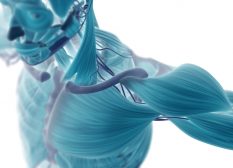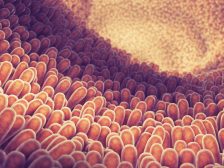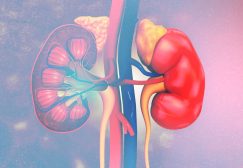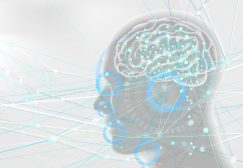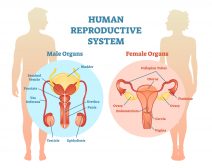
Smooth muscle
n., plural: Smooth muscles
[smuːð ˈmʌs.əl]
Definition: An involuntary, non-striated type of (vertebrate). Smooth muscle histology and diagram (inlet). Source: Modified by Maria Victoria Gonzaga of BiologyOnline.com, from the works of Juan Carlos Fonseca Mata – smooth muscle histology (photo), CC BY-SA 4.0 and OpenStax Biology- 3 types of muscle tissues (diagram), CC BY-SA 4.0.
Table of Contents
The smooth muscle can be described as a type of muscle in the human body that is non-striated and involuntary in action. Smooth muscles are essential for the body because they have many different complicated and vital tasks in the body.
Let’s talk about smooth muscles. Join us and participate in our Forum discussion: Smooth muscle vs dense regular connective tissue
Smooth Muscle Definition
Smooth muscle is a type of muscle that contracts without any voluntary control, and it is made of a thin form of layers, which is made up of spindle-shaped, unstriated cells with only one nucleus and present in inner organs walls like bladder, intestine, stomach, blood vessels, etc. excluding the heart.
These muscles are found all over the body, performing several vital functions of the body, and controlled by the nervous system. An individual does not have to worry about his or her blood pressure to respond to increased oxygen demands. The nervous system spontaneously controls smooth muscles via hormones, neurotransmitters, and other receptors.
These muscles are present in the different organs of the body, such as the gastrointestinal tract where they aid in digestion. It is also present in the urinary system and performs the electrolyte balance function to eliminate the body toxins effectively. It is also found in the different blood vessels, performing vital roles in controlling the oxygenation of tissues and pressure of blood in the body. Our body will not be able to perform such vital functions without smooth muscles.
Question: What is smooth muscle?
Answer: Smooth muscle is an involuntary, non-striated type of (vertebrate) muscle capable of slow rhythmic involuntary contractions. Smooth muscle, also called an involuntary muscle, displays no cross stripes when examined under a microscope. It is made up of spindle-shaped narrow cells with a single centrally-located nucleus. Smooth muscles contract involuntarily and slowly. A great part of internal organs and the majority of the area of the digestive tract is lined with smooth muscles.
Compare: skeletal muscle; cardiac muscle.
Question: Is smooth muscle striated?
Answer: Compared to skeletal and cardiac muscles, smooth muscles are not striated. Their name shows that they have a smooth outlook, and such muscles are used in the body system to apply force to vessels of the blood and other body organs. These muscles stretch under specific stimuli by using adenosine triphosphate as energy, and ATP usage also depends on the strength or intensity of stimuli that allows muscles to have a graded contraction.
Question: How smooth muscles are different from other muscles?
Answer: Smooth muscles are different in several ways from other body muscles, but the most notable difference is their capacity to be involuntarily contracted and regulated.
Let’s take a look at the distinctive features of smooth muscles in the next section.
Smooth Muscle Characteristics
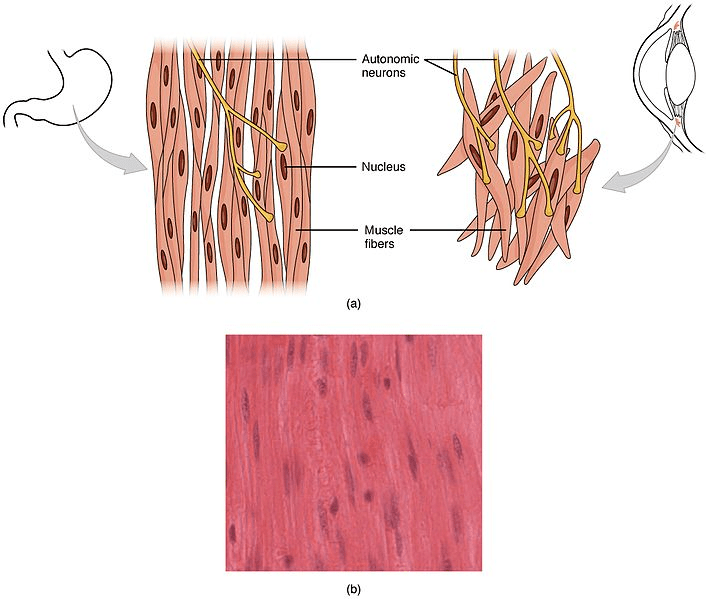
What are the characteristics of smooth muscle?
- Smooth muscle cell shape. The smooth muscle cell is fusiform in shape. The muscle cell tapers at both ends and round at the center. (See Figure 1) Smooth muscle has great elastic properties that can easily contract and relax, which is vital to organ systems, such as the stomach. It is also important in contraction and relaxation.
- The filaments. We can see the actin filaments (See Figure 3) as the red lines of smooth muscle under a microscope, and it can pass from one region of the cell to another area by joining dense bodies of the cell membrane.
- Single nucleus. The smooth muscle tissue is not striated and branched, and each cell has a single nucleus. The nucleus can be seen at the cell center and it controls all the activities within or out of the cell.
- Elasticity. The smooth muscles return to normal length after stretching. They can come back to their original size as they have elasticity.
- Contractility. Unlike the skeletal muscle tissues that can be contracted at will, the smooth muscle tissue is involuntarily controlled.
- Lack of sarcomeres. Smooth muscles lack the sarcomeres, which are present in skeletal muscles. A sarcomere is a structural unit of myofibril that consists of dark and half of the adjacent white band. It is a characteristic feature of skeletal and cardiac muscles. Does smooth muscle have sarcomeres? The structure of smooth muscle, as compared to other muscles, lacks sarcomeres.
- Lack of a tropomyosin complex. It also lacks troponin C but has calmodulin to which calcium ions bind to forming the Ca2+– calmodulin complex that activates the myosin kinase (phosphorylation enzyme).

How is a muscle tissue different from other tissues? Ask our Expert! Join us and participate in our Forum: Smooth muscle vs dense regular connective tissue
Smooth Muscle Structure, Embryonic Origin, and Histology
The thickness of smooth muscle is up to 3-10 μm thick, and it may be up to 20-200 μm in length. The cytoplasm of smooth muscles is eosinophilic and mostly made up of myofilaments. At the center of the smooth muscle is the nucleus, appearing as a cigar-like structure when it contracts.
The progenitor cells of smooth muscle cells are mesoderm as well as the neural crest cells.
Small pouch-like invaginations are formed by its cell membrane, functionally similar to the skeletal musculature’s T-tubules into the cytoplasm (caveolae).
A basal lamina anchors these cells and the underlying connective tissue.
Unlike in the skeletal muscles, smooth muscle fiber has a spindle-like shape. The fibers form sheets of tissue that work in coordination due to the gap junctions connecting these cells.
Their bundles are not purely parallel and ordered like the skeletal muscles but are composed of a complex structure. These cells can contract even faster than the skeletal muscles.
There are thick and thin filaments in the smooth muscle; however, they are not organized into sarcomeres. Thus, the filaments do not form a striated pattern. Under the microscope, it appears homogeneous. Their cytoplasm includes high concentrations of myosin and actin.
Actin and myosin
Actin and myosin proteins are the primary muscle contraction proteins. The filaments of actin adhere to dense bodies that are scattered across the cell. The filaments of myosin are lying between the filaments of actin. Under an electron microscope, thick bodies may be identified, and they look black. The calcium-containing sarcoplasmic reticulum, which enables contraction, is another significant structure present in smooth muscles.
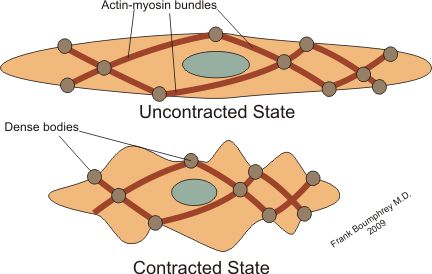
Organ system involved in smooth muscles
Smooth muscles are present in the following organs system of the body
- In the skin – erector pili of the skin
- In the urinary system (urinary bladder)
- In the reproductive system (both male and female reproductive tracts)
- In the GIT (stomach, intestine)
- In the sensory units – the eye (iris and ciliary muscle)
- In the CVS – blood vessel and lymphatic vessels
Types of Smooth muscle
Smooth muscles are of two types. They are:
- Single-unit (visceral) smooth muscle: All the cells function collectively and simultaneously as a single unit (unitary).
- Multiunit smooth muscle: It is a type of muscle in which all the cells cannot function collectively and work independently.
Single-unit smooth muscle
These cells form the walls of all inner hollow organs of the body. It creates long and uniform contractions that facilitate the passage of substances through the body, such as food digestion in the GIT.
These muscles are also present in the blood vessel, which integrate structures and control the vessel diameter by contraction and relaxation of the vessels. It is a tissue associated with the organs present inside the body, especially those in the abdominal cavity. In other words, we can say that visceral muscle is found near or in the abdomen.
Location of single-unit smooth muscle: smooth muscles are located in the internal lining of different hollow organs like the reproductive system, the urinary bladder, liver, and the circulatory system’s blood vessels, where vascular smooth muscles are oriented in a circle around the vascular lumen and form numerous layers. In the eyes, they can change iris size and lens shape. It is also present in the skin, allowing the hair to stand straight in reaction to cooler conditions or worries.
Multi-unit smooth muscle
These muscles consist of cells that cannot function collectively and work independently.
Location of multiunit smooth muscle: such muscles are mostly located in the lungs, the arrector pili muscles associated with hair follicles, in the large arteries, and also the internal eye muscles controlling the entry of light and lens formation.
Comparison between visceral and multiunit smooth muscles
Visceral smooth muscle unitary smooth muscle has a gap junction and it is a type of muscle in which all the cells function collectively and simultaneously as a single unit. In contrast, multiunit smooth muscle ones do not have gap junctions and it is a type of muscle in which all the cells cannot function collectively and work independently from each other.
Watch the video below to learn more about the differences between the single-unit and multiple-unit types of smooth muscles.
Smooth Muscle Examples
Smooth muscles are found almost in every part of your body. It is present in the following places of the body
- Smooth muscle is present in the blood vessels
- It is also present in the gallbladder
- It is present in the intestines
- Smooth muscle is present in the walls of the stomach
- It is present in the urinary system
- It is present in the iris of the eye
- The prostate is also made of smooth muscles
- It is present in the wall of the respiratory system
- It is present in the reproductive system of both the gender
- It is present in the uterus
- It is present in the arrector pili of the skin
Answer: They are located in different parts of the body. They are found in the body’s hollow organs like the intestines, digestive tracts, urinary bladder, ureters, and the blood vessels of the circulating blood system. They are also found in the wall of the lungs and the reproductive system of both genders. In blood vessels, they help in the maintenance and control of blood pressure and also help in the flow of oxygen.
Smooth Muscles Functions
Smooth muscles can function in various ways. They help the body to perform important and significant jobs, which are very important. Smooth muscles help in the housekeeping tasks of the body. Even many of the other organs are also associated with these muscles.
Questions: What is the function of smooth muscle in the body?
Answer: Few important functions are given below:
- Contraction
Like other muscles, smooth muscles also contract, and thereby, enable movement. For instance, the smooth muscles in the gut enable the food (bolus) to move through the digestive tract. - Self-working
The smooth muscle tissue functions on its own without letting the body consciously know about it. This is because it is controlled by signals from the autonomous nervous system. Imagine if breathing through our lungs have to be a conscious effort. Through smooth muscles, we are able to breathe without having to do every time at will. The smooth muscle of the blood vessels responds to CO2 by enabling vasodilation and then to oxygen by enabling vasoconstriction. Vasodilation is the widening of blood vessels and vasoconstriction is the narrowing of blood vessels. - Help in regulating homeostasis. Arrector pili muscles, for instance, are the smooth muscles attached to the skin hair follicles, help regulate body temperature by raising the hair on the skin when it’s cold. This enables the skin to generate body heat.
Smooth Muscle Dysfunction (SMD)
Multisystem SMD is a unique sort of fatal disease known as the “dysfunction of the smooth muscles” throughout the body. It is an infrequent vascular hereditary disease that gets active by a cognitional disorder of smooth muscle all over the body.
Anti-smooth muscle antibodies can be a symptom of an autoimmune disorder, such as hepatitis or lupus. Smooth muscle failure can be a reason for many fatal diseases. Many diseases are fatal and will take time to cure, but smooth muscle failure will be a much bigger problem.
As many organs are linked with smooth muscles, so damage to these muscles will ultimately cause diseases and defects to other organs and systems of the body.
Smooth Muscle Physiology: action potential
In smooth muscles, the membrane potential is responsible for initiating or modulating contraction. In comparison to skeletal muscles, the action potential in these cells is rather slower, but they can last for about fifty times more. Sodium channels are responsible for this characteristic of smooth muscles; in contrast to skeletal muscle, smooth muscle has a slower opening of sodium channels (slow repolarization).
Question: What initiates an action potential on a muscle cell?
Answer: When more amount of sodium ions moves across the plasma membrane as compared to the potassium ions, an electrochemical gradient develops. This gradient leads to depolarization of the membrane, which then initiates an action potential.

Watch the video below to learn how smooth muscle contracts and relaxes (a step by step guide)
How to Take Care of Smooth Muscles?
Smooth muscles can be looked after if we will focus a little on our diet and lifestyle. We can easily take care by doing the following tips and bits:
- Before starting any physical activity or abdominal exercise, it is crucial to spend at least 10-20 minutes warming up.
- Stretch your body by spending almost ten minutes to stretch your main muscle groups. It can drastically reduce muscle tears and help the smooth muscles contract and relax in a more specific way.
- Food significantly affects the health of smooth muscles. Your diet plays a vital role in maintaining a healthy lifestyle.
Got a question about smooth muscles? Join our Forum: Smooth muscle vs dense regular connective tissue. Our community might be able to help!
Try to answer the quiz below and see what you have learned so far about smooth muscles.
References:
- Gunner, J. (2020). Smooth Muscle Examples and Function. Retrieved 28 November 2020, from https://examples.yourdictionary.com/smooth-muscle-examples.html
- Smooth muscle | anatomy. (2020). Retrieved 28 November 2020, from https://www.britannica.com/science/smooth-muscle
- Metz, R., Patterson, J., & Wilson, E. (2011). Vascular Smooth Muscle Cells: Isolation, Culture, and Characterization. Methods in Molecular Biology, 169-176. DOI: 10.1007/978-1-61779-523-7_16
- Taylor, T. (2015). Visceral Muscle Tissue – Anatomy Pictures and Information. Retrieved 28 November 2020, from https://www.innerbody.com/image_musc01/musc02.html#:~:text=Visceral%20muscle%20tissue%2C%20or%20smooth,skeletal%2C%20smooth%2C%20and%20cardiac.
- Chen, S. N., Wang, Y. Q., Hao, C. L., Lu, Y. H., Jiang, W. J., Gao, C. Y., & Wu, M. (2019). Multisystem smooth muscle dysfunction syndrome in a Chinese girl: A case report and review of the literature. World journal of clinical cases, 7(24), 4355–4365. https://doi.org/10.12998/wjcc.v7.i24.4355
- Sinha S, Iyer D, Granata A. Embryonic origins of human vascular smooth muscle cells: implications for in vitro modeling and clinical application. Cell Mol Life Sci. 2014 Jun;71(12):2271-88.
- Bargehr, J., Low, L., Cheung, C., Bernard, W. G., Iyer, D., Bennett, M. R., Gambardella, L., & Sinha, S. (2016). Embryological Origin of Human Smooth Muscle Cells Influences Their Ability to Support Endothelial Network Formation. STEM CELLS Translational Medicine, 5(7), 946–959. https://doi.org/10.5966/sctm.2015-0282
©BiologyOnline.com. Content provided and moderated by BiologyOnline Editors.

